High Phenotypic Variation between an In Vitro-Passaged Fowl Adenovirus Serotype 1 (FAdV-1) and Its Virulent Progenitor Strain despite Almost Complete Sequence Identity of the Whole Genomes
Abstract
:1. Introduction
2. Materials and Methods
2.1. Preparation of Primary Chicken Embryo Liver (CEL) Cells
2.2. Virus Origin and Preparation
2.3. Virus Replication Kinetics In Vitro
2.4. Whole Genome Sequencing and Analysis
2.5. In Vivo Study—Experimental Design and Sampling
2.6. Histology
2.7. Virus Isolation and Quantitative PCR (qPCR)
2.8. Detection of Virus Neutralizing Antibodies
2.9. Statistics
3. Results
3.1. Virus Replication In Vitro
3.2. Molecular Analysis and Whole Genome Sequence Comparison
3.3. In Vivo Study—Clinical Signs and Lesions
3.4. Virus Excretion and Detection in Target Organs
3.5. Antibody Development
4. Discussion
Supplementary Materials
Author Contributions
Funding
Institutional Review Board Statement
Informed Consent Statement
Data Availability Statement
Acknowledgments
Conflicts of Interest
References
- Harrach, B.; Benko, M.; Both, G.W.; Brown, M.; Davison, A.J.; Echavarria, M.; Hess, M.; Jones, M.S.; Kajon, A.; Lehmkuhl, H.D.; et al. Adenoviridae. In Virus Taxonomy; Elsevier: San Diego, CA, USA, 2012; pp. 125–141. ISBN 9780123846846. [Google Scholar]
- Hess, M. Detection and differentiation of avian adenoviruses: A review. Avian Pathol. 2000, 29, 195–206. [Google Scholar] [CrossRef] [PubMed]
- McFerran, J.B.; Smyth, J.A. Avian adenoviruses. Rev. Sci. Tech. 2000, 19, 589–601. [Google Scholar] [CrossRef] [PubMed]
- Niczyporuk, J.S. Phylogenetic and geographic analysis of fowl adenovirus field strains isolated from poultry in Poland. Arch. Virol. 2016, 161, 33–42. [Google Scholar] [CrossRef]
- Mirzazadeh, A.; Grafl, B.; Berger, E.; Schachner, A.; Hess, M. Longitudinal serological monitoring of commercial broiler breeders for fowl adenoviruses (FAdVs)—Presence of antibodies is linked with virus excretion. Avian Dis. 2020, 65, 177–187. [Google Scholar] [CrossRef]
- Niu, Y.; Sun, Q.; Zhang, G.; Sun, W.; Liu, X.; Xiao, Y.; Shang, Y.; Liu, S. Epidemiological investigation of outbreaks of fowl adenovirus infections in commercial chickens in China. Transbound. Emerg. Dis. 2018, 65, e121–e126. [Google Scholar] [CrossRef]
- Cook, J.K. Fowl adenoviruses: Studies on aspects of the pathogenicity of six strains for 1-day-old chicks. Avian Pathol. 1983, 12, 35–43. [Google Scholar] [CrossRef] [PubMed]
- Okuda, Y.; Ono, M.; Shibata, I.; Sato, S.; Akashi, H. Comparison of the polymerase chain reaction-restriction fragment length polymorphism pattern of the fiber gene and pathogenicity of serotype-1 fowl adenovirus isolates from gizzard erosions and from feces of clinically healthy chickens in Japan. J. Vet. Diagn. Investig. 2006, 18, 162–167. [Google Scholar] [CrossRef] [Green Version]
- Marek, A.; Schulz, E.; Hess, C.; Hess, M. Comparison of the fibers of Fowl adenovirus A serotype 1 isolates from chickens with gizzard erosions in Europe and apathogenic reference strains. J. Vet. Diagn. Investig. 2010, 22, 937–941. [Google Scholar] [CrossRef] [Green Version]
- Hess, M. Aviadenovirus Infections. In Diseases of Poultry, 14th ed.; Swayne, D.E., Boulianne, M., Logue, C.M., McDougald, L.R., Nair, V., Suarez, D.L., Eds.; Wiley-Blackwell: Hoboken, NJ, USA, 2020; pp. 322–332. ISBN 9781119371168. [Google Scholar]
- Hess, M. Commensal or pathogen—A challenge to fulfil Koch’s Postulates. Br. Poult. Sci. 2017, 58, 1–12. [Google Scholar] [CrossRef]
- Abe, T.; Nakamura, K.; Tojo, T.; Yuasa, N. Gizzard erosion in broiler chicks by group I avian adenovirus. Avian Dis. 2001, 45, 234–239. [Google Scholar] [CrossRef]
- Grafl, B.; Aigner, F.; Liebhart, D.; Marek, A.; Prokofieva, I.; Bachmeier, J.; Hess, M. Vertical transmission and clinical signs in broiler breeders and broilers experiencing adenoviral gizzard erosion. Avian Pathol. 2012, 41, 599–604. [Google Scholar] [CrossRef]
- Schade, B.; Schmitt, F.; Böhm, B.; Alex, M.; Fux, R.; Cattoli, G.; Terregino, C.; Monne, I.; Currie, R.J.W.; Olias, P. Adenoviral gizzard erosion in broiler chickens in Germany. Avian Dis. 2013, 57, 159–163. [Google Scholar] [CrossRef] [PubMed]
- Mirzazadeh, A.; Grafl, B.; Abbasnia, M.; Emadi-Jamali, S.; Abdi-Hachesoo, B.; Schachner, A.; Hess, M. Reduced Performance Due to Adenoviral Gizzard Erosion in 16-Day-Old Commercial Broiler Chickens in Iran, Confirmed Experimentally. Front. Vet. Sci. 2021, 8, 635186. [Google Scholar] [CrossRef] [PubMed]
- Lim, T.-H.; Kim, B.-Y.; Kim, M.-S.; Jang, J.-H.; Lee, D.-H.; Kwon, Y.-K.; Lee, J.-B.; Park, S.-Y.; Choi, I.-S.; Song, C.-S. Outbreak of gizzard erosion associated with fowl adenovirus infection in Korea. Poult. Sci. 2012, 91, 1113–1117. [Google Scholar] [CrossRef] [PubMed]
- Grafl, B.; Garcia-Rueda, C.; Cargill, P.; Wood, A.; Schock, A.; Liebhart, D.; Schachner, A.; Hess, M. Fowl aviadenovirus serotype 1 confirmed as the aetiological agent of gizzard erosions in replacement pullets and layer flocks in Great Britain by laboratory and in vivo studies. Avian Pathol. 2018, 47, 63–72. [Google Scholar] [CrossRef] [PubMed]
- Ono, M.; Okuda, Y.; Yazawa, S.; Shibata, I.; Tanimura, N.; Kimura, K.; Haritani, M.; Mase, M.; Sato, S. Epizootic outbreaks of gizzard erosion associated with adenovirus infection in chickens. Avian Dis. 2001, 45, 268–275. [Google Scholar] [CrossRef]
- Manarolla, G.; Pisoni, G.; Moroni, P.; Gallazzi, D.; Sironi, G.; Rampin, T. Adenoviral gizzard erosions in Italian chicken flocks. Vet. Rec. 2009, 164, 754–756. [Google Scholar] [CrossRef] [Green Version]
- Mirzazadeh, A.; Asasi, K.; Schachner, A.; Mosleh, N.; Liebhart, D.; Hess, M.; Grafl, B. Gizzard Erosion Associated with Fowl Adenovirus Infection in Slaughtered Broiler Chickens in Iran. Avian Dis. 2019, 63, 568–576. [Google Scholar] [CrossRef]
- Schachner, A.; Matos, M.; Grafl, B.; Hess, M. Fowl adenovirus-induced diseases and strategies for their control—A review on the current global situation. Avian Pathol. 2018, 47, 111–126. [Google Scholar] [CrossRef]
- Galinski, M.S.; Sra, K.; Haynes, J.I.; Naspinski, J. Live Attenuated Viral Vaccines. In Vaccine Analysis: Strategies, Principles, and Control; Nunnally, B.K., Turula, V.E., Sitrin, R.D., Eds.; Springer: Berlin/Heidelberg, Germany, 2015; pp. 1–44. ISBN 978-3-662-45023-9. [Google Scholar]
- Schonewille, E.; Jaspers, R.; Paul, G.; Hess, M. Specific-pathogen-free chickens vaccinated with a live FAdV-4 vaccine are fully protected against a severe challenge even in the absence of neutralizing antibodies. Avian Dis. 2010, 54, 905–910. [Google Scholar] [CrossRef]
- Mansoor, M.K.; Hussain, I.; Arshad, M.; Muhammad, G. Preparation and evaluation of chicken embryo-adapted fowl adenovirus serotype 4 vaccine in broiler chickens. Trop. Anim. Health Prod. 2011, 43, 331–338. [Google Scholar] [CrossRef] [PubMed]
- Sohaimi, N.M.; Hair-Bejo, M.; Omar, A.R.; Ideris, A.; Mat Isa, N. Molecular characterization of fowl adenovirus isolate of Malaysia attenuated in chicken embryo liver cells and its pathogenicity and immunogenicity in chickens. PLoS ONE 2019, 14, e0225863. [Google Scholar] [CrossRef]
- Zhang, Y.; Liu, R.; Tian, K.; Wang, Z.; Yang, X.; Gao, D.; Zhang, Y.; Fu, J.; Wang, H.; Zhao, J. Fiber2 and hexon genes are closely associated with the virulence of the emerging and highly pathogenic fowl adenovirus 4. Emerg. Microbes Infect. 2018, 7, 199. [Google Scholar] [CrossRef] [PubMed] [Green Version]
- Vera-Hernández, P.F.; Morales-Garzón, A.; Cortés-Espinosa, D.V.; Galiote-Flores, A.; García-Barrera, L.J.; Rodríguez-Galindo, E.T.; Toscano-Contreras, A.; Lucio-Decanini, E.; Absalón, A.E. Clinicopathological characterization and genomic sequence differences observed in a highly virulent fowl Aviadenovirus serotype 4. Avian Pathol. 2016, 45, 73–81. [Google Scholar] [CrossRef] [PubMed] [Green Version]
- Slaine, P.D.; Ackford, J.G.; Kropinski, A.M.; Kozak, R.A.; Krell, P.J.; Nagy, E. Molecular characterization of pathogenic and non-pathogenic fowl aviadenovirus serotype 11 isolates. Can. J. Microbiol. 2016, 62, 993–1002. [Google Scholar] [CrossRef] [PubMed]
- Absalón, A.E.; Morales-Garzón, A.; Vera-Hernández, P.F.; Cortés-Espinosa, D.V.; Uribe-Ochoa, S.M.; García, L.J.; Lucio-Decanini, E. Complete genome sequence of a non-pathogenic strain of Fowl Adenovirus serotype 11: Minimal genomic differences between pathogenic and non-pathogenic viruses. Virology 2017, 501, 63–69. [Google Scholar] [CrossRef]
- Schachner, A.; Gonzalez, G.; Endler, L.; Ito, K.; Hess, M. Fowl Adenovirus (FAdV) Recombination with Intertypic Crossovers in Genomes of FAdV-D and FAdV-E, Displaying Hybrid Serological Phenotypes. Viruses 2019, 11, 1094. [Google Scholar] [CrossRef] [Green Version]
- Schachner, A.; Grafl, B.; Hess, M. Spotlight on avian pathology: Fowl adenovirus (FAdV) in chickens and beyond—An unresolved host-pathogen interplay. Avian Pathol. 2021, 50, 2–5. [Google Scholar] [CrossRef]
- Zhang, Y.; Liu, A.; Wang, Y.; Cui, H.; Gao, Y.; Qi, X.; Liu, C.; Zhang, Y.; Li, K.; Gao, L.; et al. A Single Amino Acid at Residue 188 of the Hexon Protein Is Responsible for the Pathogenicity of the Emerging Novel Virus Fowl Adenovirus 4. J. Virol. 2021, 95, e0060321. [Google Scholar] [CrossRef]
- Xie, Q.; Wang, W.; Li, L.; Kan, Q.; Fu, H.; Geng, T.; Li, T.; Wan, Z.; Gao, W.; Shao, H.; et al. Domain in Fiber-2 interacted with KPNA3/4 significantly affects the replication and pathogenicity of the highly pathogenic FAdV-4. Virulence 2021, 12, 754–765. [Google Scholar] [CrossRef]
- Dufour-Zavala, L.; Swayne, D.E.; Glisson, J.R.; Pearson, J.E.; Reed, W.M.; Jackwood, M.W.; Woolcock, P.R. (Eds.) A Laboratory Manual for the Isolation, Identification and Characterization of Avian Pathogens: Cell-Culture Methods, 5th ed.; American Association of Avian Pathologists: Athens, GA, USA, 2008. [Google Scholar]
- Grafl, B.; Liebhart, D.; Günes, A.; Wernsdorf, P.; Aigner, F.; Bachmeier, J.; Hess, M. Quantity of virulent fowl adenovirus serotype 1 correlates with clinical signs, macroscopical and pathohistological lesions in gizzards following experimental induction of gizzard erosion in broilers. Vet. Res. 2013, 44, 38. [Google Scholar] [CrossRef] [Green Version]
- Grafl, B.; Prokofieva, I.; Wernsdorf, P.; Steinborn, R.; Hess, M. Infection with an apathogenic fowl adenovirus serotype-1 strain (CELO) prevents adenoviral gizzard erosion in broilers. Vet. Microbiol. 2014, 172, 177–185. [Google Scholar] [CrossRef] [PubMed]
- Reed, L.J.; Muench, E. A simple method of estimating fifty per cent endpoints. Am. J. Epidemiol. 1938, 27, 493–497. [Google Scholar] [CrossRef]
- Alexander, H.; Huber, P.; Cao, J.; Krell, P.; Nagy, É. Growth characteristics of fowl adenovirus type 8 in a chicken hepatoma cell line. J. Virol. Methods 1998, 74, 9–14. [Google Scholar] [CrossRef]
- Günes, A.; Marek, A.; Grafl, B.; Berger, E.; Hess, M. Real-time PCR assay for universal detection and quantitation of all five species of fowl adenoviruses (FAdV-A to FAdV-E). J. Virol. Methods 2012, 183, 147–153. [Google Scholar] [CrossRef] [PubMed]
- Kraft, V.; Tischer, I. Cell cycle-dependent multiplication of avian adenoviruses in chicken embryo fibroblasts. Arch. Virol. 1978, 57, 243–254. [Google Scholar] [CrossRef]
- Bellett, A.; Younghusband, H. Replication of the DNA of Chicken Embryo Lethal Orphan Virus. J. Mol. Biol. 1972, 72, 691–709. [Google Scholar] [CrossRef]
- Nakamura, K.; Ohyama, T.; Yamada, M.; Abe, T.; Tanaka, H.; Mase, M. Experimental gizzard erosions in specific-pathogen-free chicks by serotype 1 group I avian adenoviruses from broilers. Avian Dis. 2002, 46, 893–900. [Google Scholar] [CrossRef]
- Domingo, E.; de Ávila, A.I.; Gallego, I.; Sheldon, J.; Perales, C. Viral fitness: History and relevance for viral pathogenesis and antiviral interventions. Pathog. Dis. 2019, 77, ftz021. [Google Scholar] [CrossRef]
- Tan, P.K.; Michou, A.I.; Bergelson, J.M.; Cotten, M. Defining CAR as a cellular receptor for the avian adenovirus CELO using a genetic analysis of the two viral fibre proteins. J. Gen. Virol. 2001, 82, 1465–1472. [Google Scholar] [CrossRef] [Green Version]
- Philipson, L.; Lonberg-Holm, K.; Pettersson, U. Virus-Receptor Interaction in an Adenovirus System. J. Virol. 1968, 2, 1064–1075. [Google Scholar] [CrossRef] [PubMed] [Green Version]
- Pallister, J.; Wright, P.J.; Sheppard, M. A single gene encoding the fiber is responsible for variations in virulence in the fowl adenoviruses. J. Virol. 1996, 70, 5115–5122. [Google Scholar] [CrossRef] [PubMed] [Green Version]
- Matczuk, A.K.; Niczyporuk, J.S.; Kuczkowski, M.; Woźniakowski, G.; Nowak, M.; Wieliczko, A. Whole genome sequencing of Fowl aviadenovirus A—A causative agent of gizzard erosion and ulceration, in adult laying hens. Infect. Genet. Evol. 2017, 48, 47–53. [Google Scholar] [CrossRef] [PubMed]
- Levinson, G.; Gutman, G.A. Slipped-strand mispairing: A major mechanism for DNA sequence evolution. Mol. Biol. Evol. 1987, 4, 203–221. [Google Scholar]
- Hancock, J.M.; Chaleeprom, W.; Chaleeprom, W.; Dale, J.; Gibbs, A. Replication slippage in the evolution of potyviruses. J. Gen. Virol. 1995, 76, 3229–3232. [Google Scholar] [CrossRef] [PubMed]
- Ojkic, D.; Krell, P.J.; Nagy, E. Unique features of fowl adenovirus 9 gene transcription. Virology 2002, 302, 274–285. [Google Scholar] [CrossRef]
- Griffin, B.D.; Nagy, É. Coding potential and transcript analysis of fowl adenovirus 4: Insight into upstream ORFs as common sequence features in adenoviral transcripts. J. Gen. Virol. 2011, 92, 1260–1272. [Google Scholar] [CrossRef]
- Li, R.; Li, G.; Lin, J.; Han, S.; Hou, X.; Weng, H.; Guo, M.; Lu, Z.; Li, N.; Shang, Y.; et al. Fowl Adenovirus Serotype 4 SD0828 Infections Causes High Mortality Rate and Cytokine Levels in Specific Pathogen-Free Chickens Compared to Ducks. Front. Immunol. 2018, 9, 49. [Google Scholar] [CrossRef] [Green Version]
- Grgić, H.; Poljak, Z.; Sharif, S.; Nagy, É. Pathogenicity and cytokine gene expression pattern of a serotype 4 fowl adenovirus isolate. PLoS ONE 2013, 8, e77601. [Google Scholar] [CrossRef]
- Zhang, J.; Zou, Z.; Huang, K.; Lin, X.; Chen, H.; Jin, M. Insights into leghorn male hepatocellular cells response to fowl adenovirus serotype 4 infection by transcriptome analysis. Vet. Microbiol. 2018, 214, 65–74. [Google Scholar] [CrossRef]
- Chen, Y.; Huang, R.; Qu, G.; Peng, Y.; Xu, L.; Wang, C.; Huang, C.; Wang, Q. Transcriptome Analysis Reveals New Insight of Fowl Adenovirus Serotype 4 Infection. Front. Microbiol. 2020, 11, 146. [Google Scholar] [CrossRef] [PubMed] [Green Version]
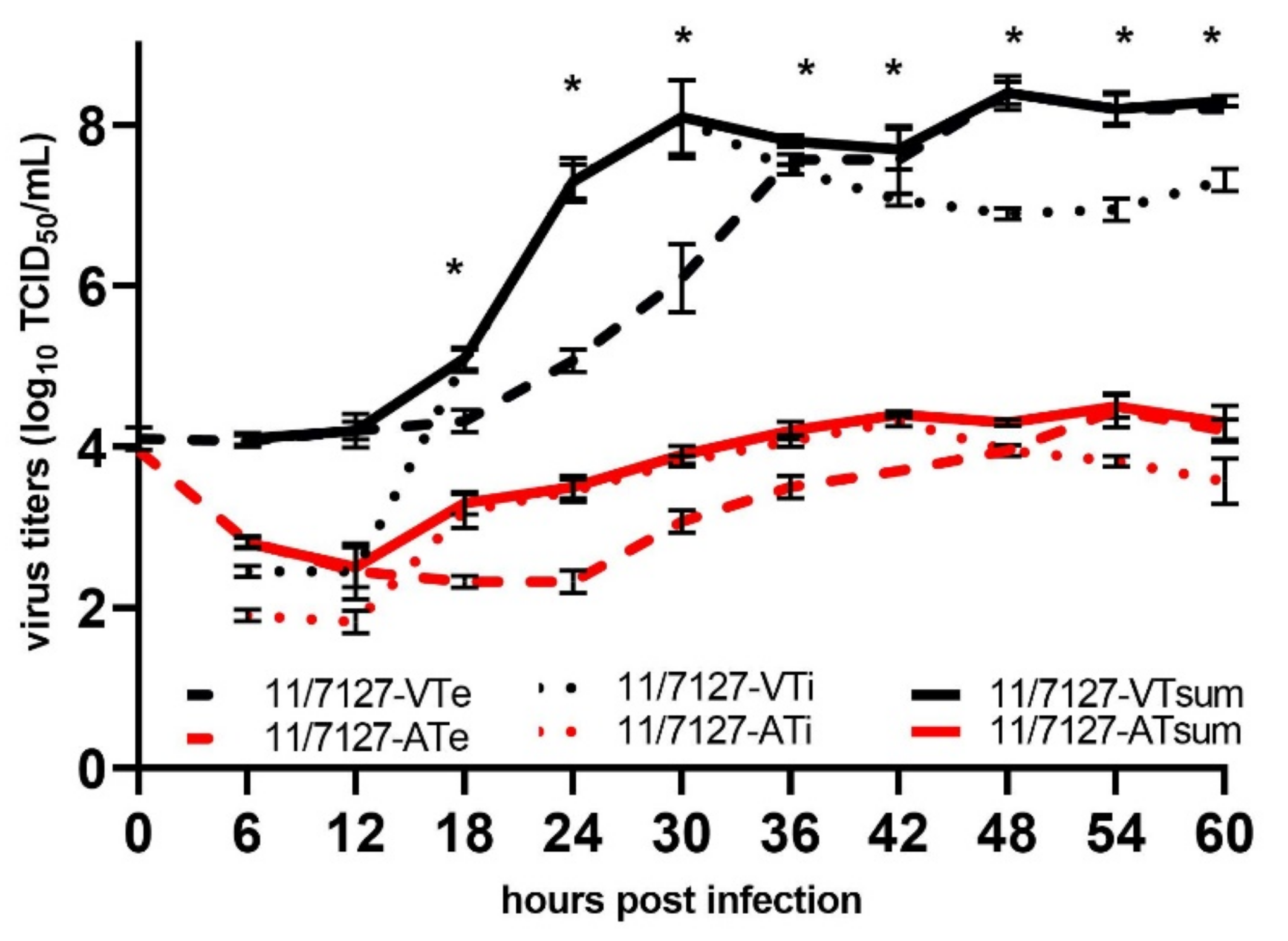
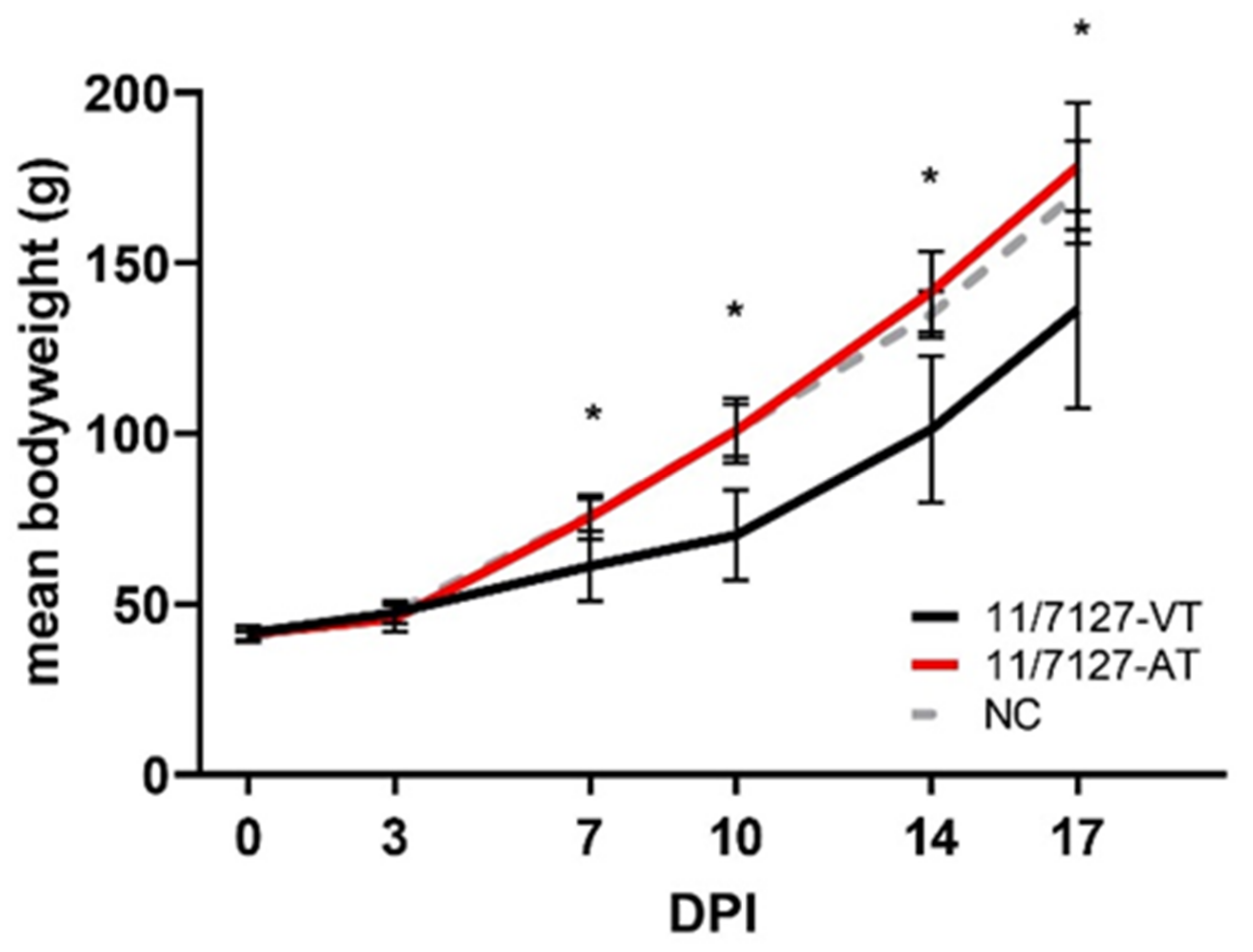
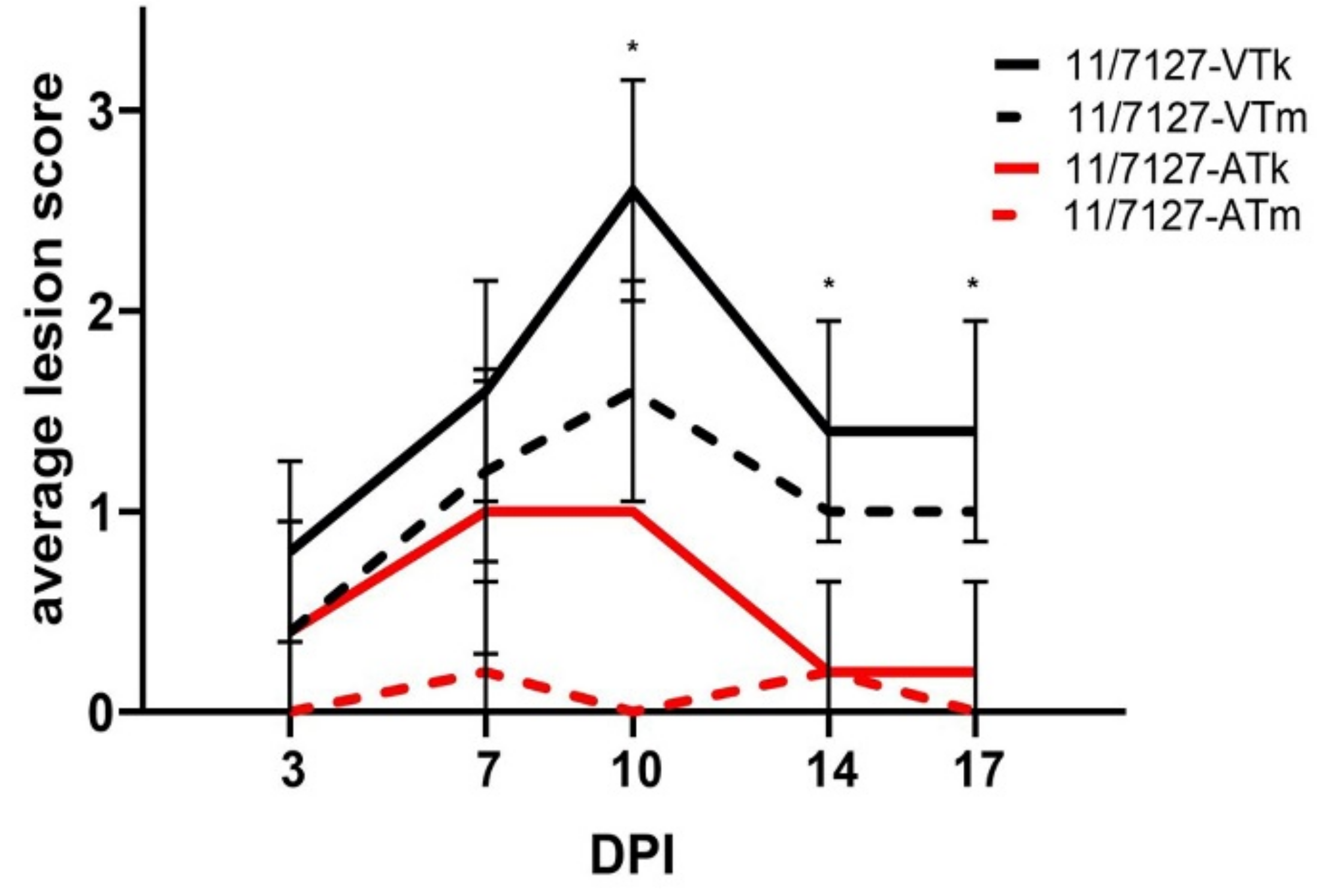
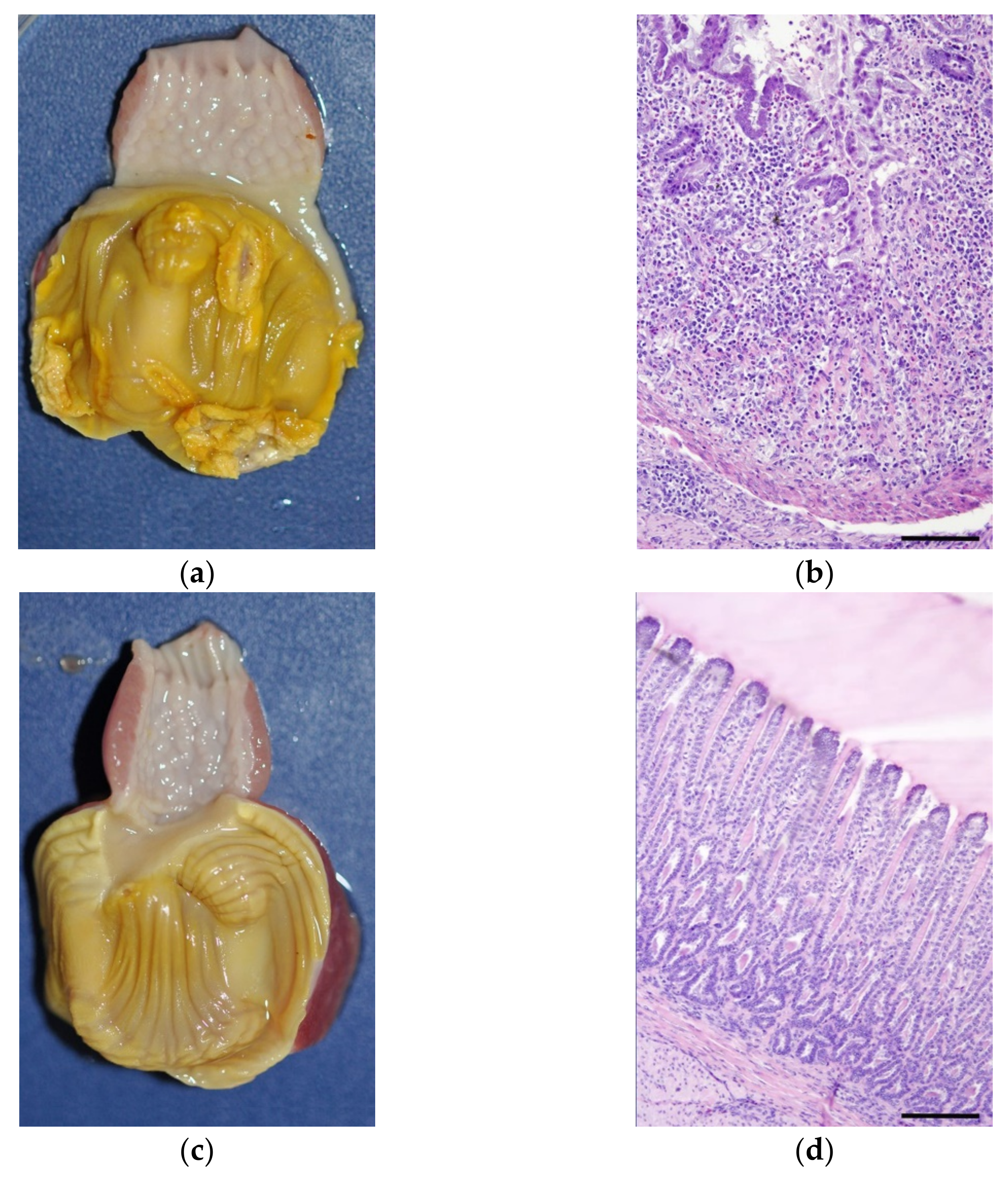
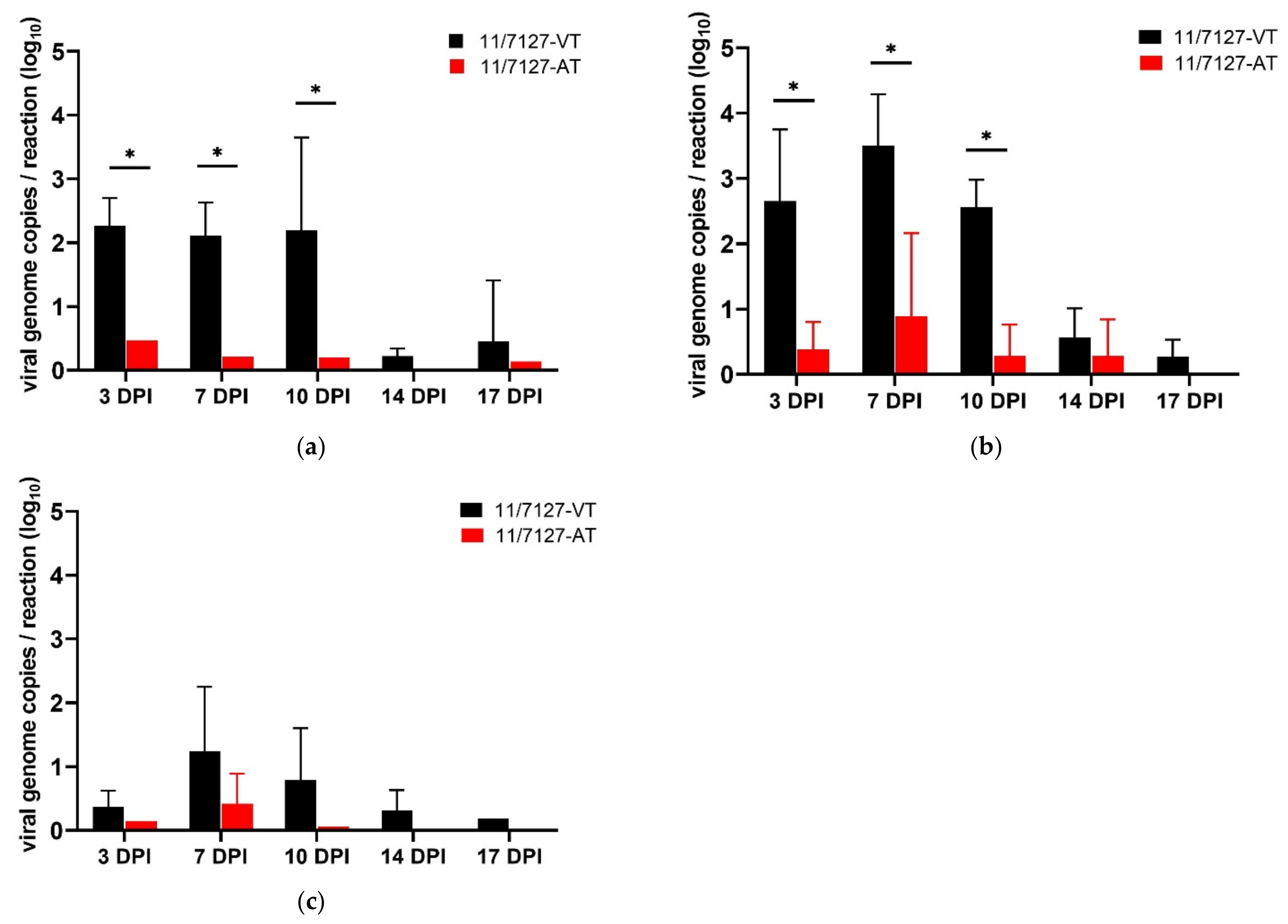
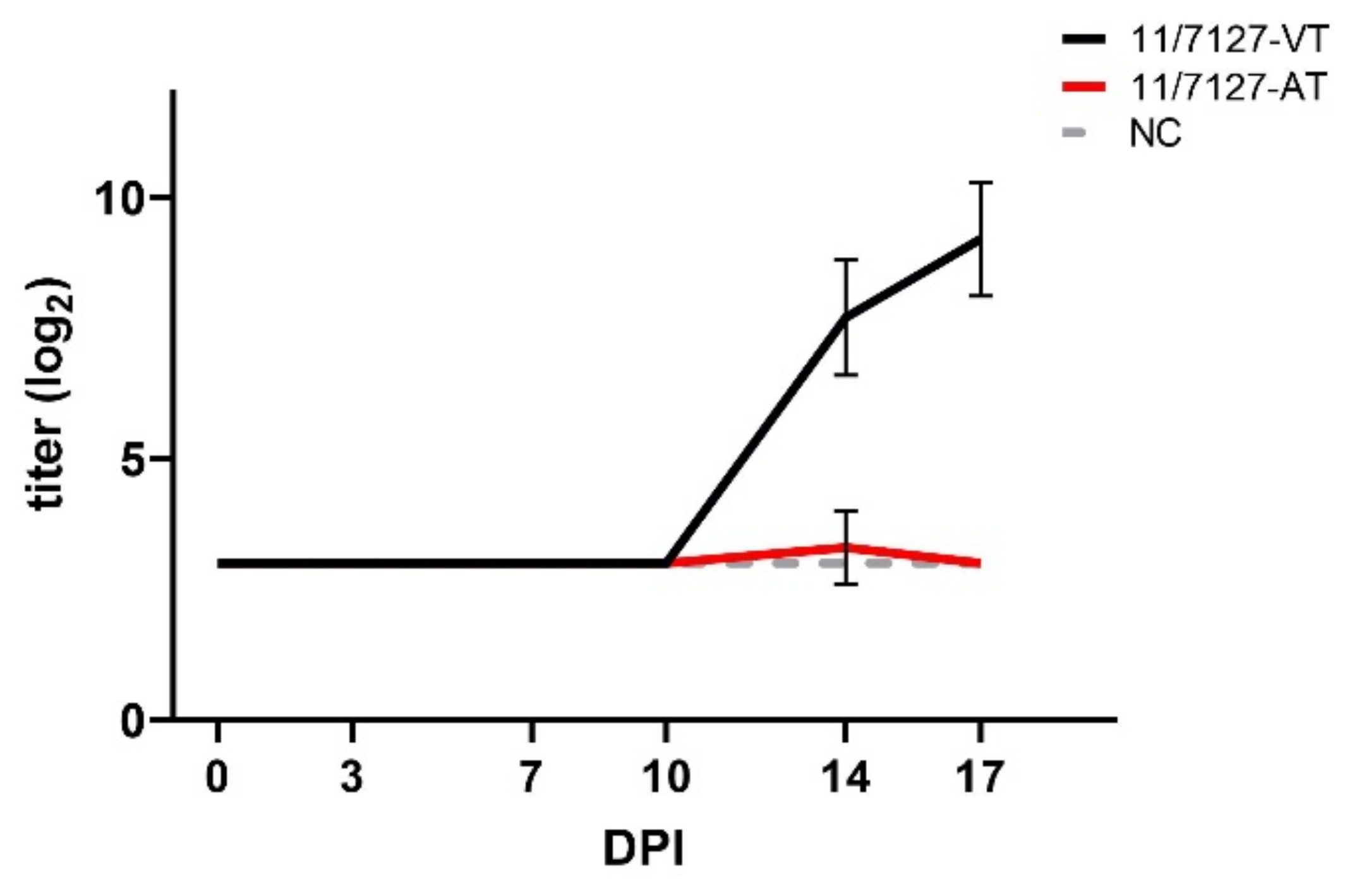
| Group 11/7127-VT | Group 11/7127-AT | |||||||||||
|---|---|---|---|---|---|---|---|---|---|---|---|---|
| Gizzard | Liver | Cloacal Swabs | Gizzard | Liver | Cloacal Swabs | |||||||
| CEL | qPCR | CEL | qPCR | CEL | qPCR | CEL | qPCR | CEL | qPCR | CEL | qPCR | |
| 0 DPI | n/a a | n/a | n/a | n/a | 0/5 | 0/5 | n/a | n/a | n/a | n/a | 0/5 | 0/5 |
| 3 DPI | 5/5 | 5/5 | 4/5 | 5/5 | 5/5 | 5/5 | 3/5 | 3/5 | 0/5 | 1/5 | 0/5 | 1/5 |
| 7 DPI | 5/5 | 5/5 | 4/5 | 5/5 | 5/5 | 5/5 | 2/5 | 3/5 | 1/5 | 3/5 | 1/5 | 1/5 |
| 10 DPI | 5/5 | 5/5 | 3/5 | 5/5 | 5/5 | 5/5 | 1/5 | 1/5 | 0/5 | 1/5 | 1/5 | 1/5 |
| 14 DPI | 0/5 | 4/5 | 0/5 | 4/5 | 3/5 | 5/5 | 0/5 | 3/5 | 0/5 | 0/5 | 0/5 | 0/5 |
| 17 DPI | 0/5 | 3/5 | 0/5 | 1/5 | 2/5 | 4/5 | 0/5 | 0/5 | 0/5 | 0/5 | 1/5 | 1/5 |
| Total | 15/25 | 22/25 | 11/25 | 20/25 | 20/25 | 24/25 | 6/25 | 10/25 | 1/25 | 5/25 | 3/25 | 4/25 |
Publisher’s Note: MDPI stays neutral with regard to jurisdictional claims in published maps and institutional affiliations. |
© 2022 by the authors. Licensee MDPI, Basel, Switzerland. This article is an open access article distributed under the terms and conditions of the Creative Commons Attribution (CC BY) license (https://creativecommons.org/licenses/by/4.0/).
Share and Cite
Grafl, B.; Schachner, A.; Hess, M. High Phenotypic Variation between an In Vitro-Passaged Fowl Adenovirus Serotype 1 (FAdV-1) and Its Virulent Progenitor Strain despite Almost Complete Sequence Identity of the Whole Genomes. Viruses 2022, 14, 358. https://doi.org/10.3390/v14020358
Grafl B, Schachner A, Hess M. High Phenotypic Variation between an In Vitro-Passaged Fowl Adenovirus Serotype 1 (FAdV-1) and Its Virulent Progenitor Strain despite Almost Complete Sequence Identity of the Whole Genomes. Viruses. 2022; 14(2):358. https://doi.org/10.3390/v14020358
Chicago/Turabian StyleGrafl, Beatrice, Anna Schachner, and Michael Hess. 2022. "High Phenotypic Variation between an In Vitro-Passaged Fowl Adenovirus Serotype 1 (FAdV-1) and Its Virulent Progenitor Strain despite Almost Complete Sequence Identity of the Whole Genomes" Viruses 14, no. 2: 358. https://doi.org/10.3390/v14020358
APA StyleGrafl, B., Schachner, A., & Hess, M. (2022). High Phenotypic Variation between an In Vitro-Passaged Fowl Adenovirus Serotype 1 (FAdV-1) and Its Virulent Progenitor Strain despite Almost Complete Sequence Identity of the Whole Genomes. Viruses, 14(2), 358. https://doi.org/10.3390/v14020358






